Belated Flowers (Gibson-Jack the third)
I'm behind on these. Luckily on more recent trips, I've seen lots and lots of repeats, so there won't be as many new ones. Anyway, these are the last flowers I'll be posting from Gibson Jack. Yes, that means there are more that I have not posted. I've got others from Hell's Half-Acre (Wednesday), Lava Hot Springs (Friday) and Massacre Rocks (yesterday = Monday) that I haven't even sorted through yet.
Oh, and if you've been wondering why I'm so into the flowers, it's mostly because I like to know what I'm looking at when I go hiking. Carrying guidebooks with me is not practical. They're heavy and awkward, and generally I'm more interested in just hiking than in stopping to pull out a book. If I capture the flowers in pictures, I can look them up at my leisure. At the very least, I like to know the basic identities (there's a lupine; that one's fleabane; some sort of penstemon...) and which ones are edible. More importantly, which ones are poisonous. :^D Posting them here gives me incentive to actually get the looking-up part done, and also gives me a record of which ones I've encountered already.
Oh, one source that I don't think I've used yet was helpful on a few of these: National Audubon Society: Field Guide to the Rocky Mountains.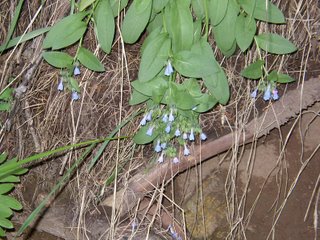 Mountain bluebells, Mertensia ciliate. These were in a shaded area, near the Solomon plant. I'm not sure why they were growing up-side down.
Mountain bluebells, Mertensia ciliate. These were in a shaded area, near the Solomon plant. I'm not sure why they were growing up-side down.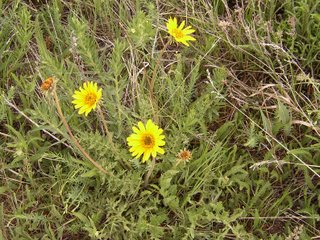 Wooly sunflower, Eriophyllum lanatum. At least, that seems to be the closest matching sunflower. I often ignore stuff that looks like sunflowers because it's often difficult to tell which is which.
Wooly sunflower, Eriophyllum lanatum. At least, that seems to be the closest matching sunflower. I often ignore stuff that looks like sunflowers because it's often difficult to tell which is which.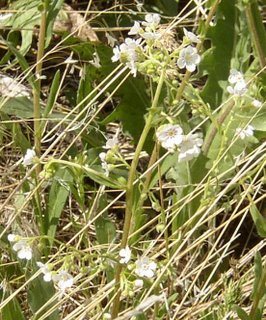 American Speedwell, Veronica americana. This was all over the place up at Gibson Jack. Seems that all Veronica species are edible, but become bitter as they get older. High in Vitamin C.
American Speedwell, Veronica americana. This was all over the place up at Gibson Jack. Seems that all Veronica species are edible, but become bitter as they get older. High in Vitamin C.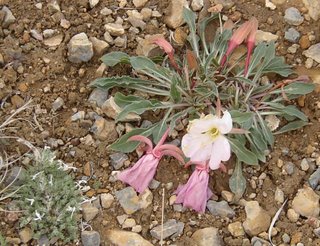 The larger, more prominent flower is Moon-Rose, aka White Evening Primrose, Oenothera cespitosa. "Evening" primrose seems to be because they open in the evenings and are pollinated by night-flying insects, especially moths. I didn't try to find the smaller flower at the bottom left.
The larger, more prominent flower is Moon-Rose, aka White Evening Primrose, Oenothera cespitosa. "Evening" primrose seems to be because they open in the evenings and are pollinated by night-flying insects, especially moths. I didn't try to find the smaller flower at the bottom left. Pale Comandra, Comandra umbellata. In small quantities, its fruits seem to be edible (in large quantities they may make people nauseous). Oddly, the fruits are said to be tastiest before they are fully ripe.
Pale Comandra, Comandra umbellata. In small quantities, its fruits seem to be edible (in large quantities they may make people nauseous). Oddly, the fruits are said to be tastiest before they are fully ripe.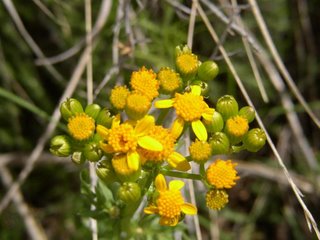 Curlycup Gumweed, Grindelia squarrosa. This one took me a while to find, but it was the almost bead-like center that identified it. These aren't fully in bloom yet. You can see a few of the petals just starting to open out. Anyway, the name comes from natives supposedly chewing the blossoms as gum.
Curlycup Gumweed, Grindelia squarrosa. This one took me a while to find, but it was the almost bead-like center that identified it. These aren't fully in bloom yet. You can see a few of the petals just starting to open out. Anyway, the name comes from natives supposedly chewing the blossoms as gum.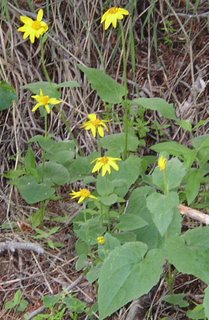 Heartleaf Arnica, Arnica cordifolia. Hmmm... some native tribes used leaves from various arnica's on cuts and bruises, and one tribe used the leaves as a love-charm. *shrugs*
Heartleaf Arnica, Arnica cordifolia. Hmmm... some native tribes used leaves from various arnica's on cuts and bruises, and one tribe used the leaves as a love-charm. *shrugs*




No comments:
Post a Comment